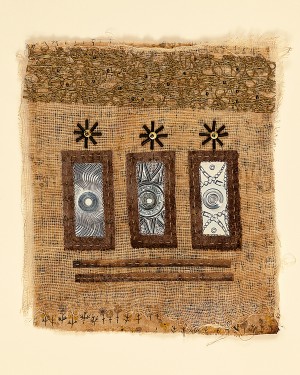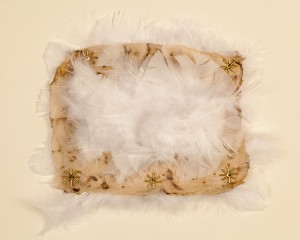Tackling Hate Speech With Textiles: Robin Atlas in New York for Tu B’Shvat
“Lashon hara,” Seattle-based artist Robin Atlas tells me, “is a universal issue that goes way beyond the personal level, even the laws of Judaism. The whole world could be changed for the better if people would be mindful of their speech.”
Working in mixed media, mainly textile art, Atlas elevates lashon hara into the broader context of intolerance, anti-Semitism, xenophobia, racism and discrimination.
Atlas invites viewers to join her in expanding the conversation in her interactive exhibit “Lashon Hara: On the Consequences of Hate Speech,” at the Anne Frank Center in New York through late February, presented in conjunction with the Jewish Art Salon.
“The idea for the narrative [of the works on view] sprang from a conversation I had with my rebbetzin concerning someone who made an unkind remark about me to a small group of people. The rebbetzin characterized the remark as lashon hara. I had some knowledge of lashon hara inasmuch as I understood that as Jews we should not speak ill of one another, but that day the rebbetzin gave me a deeper understanding about what it was and the damage that springs from it. What she also did was pique my curiosity.”
The more Atlas learned about the Jewish laws, writings and Midrash about lashon hara — especially through the teachings of the Chofetz Chaim, the influential Musar rabbi — the more fascinated she became. One day, she says, she was struck suddenly.
“It occurred to me that the repercussions of evil speech and all of the hatred and darkness that springs from it was the foundation of everything that was wrong with our world,” she says. “I saw it as transcending Judaism.”
One of the pieces, “Feather Pillow” for example, features a Jewish folk story about a person who says something bad about another. Words are like feathers, once in the air, flying away, they cannot be caught and retracted. Those who spread gossip commit three “murders”: they kill the souls of the speaker, of the listener and the one about whom they gossip. Another artwork in the show, “Three Murders,” also illustrates this.
Atlas says she is one of “a growing number of artists” using visual Midrash, “the expression of Jewish teaching through artwork.”
Other pieces, such as the “Bomb,” capture more personal lessons the artist learned about lashon hara: Even though evil speech creates darkness, the Jewish response must be to turn it around.
“The key,” Atlas says, “is to stay in the light.” As an example, she created a bomb of kindness out of beautiful, sparkling, golden beads. She also created an image of the Chofetz Chaim surrounded by letters over letters, on the bottom layer in plain brown, others sewn over them by a golden thread of light, symbolizing two sides of a story, or the opportunity to bring lightness over the dark.
The Anne Frank Center — at the forefront of educating children and grownups about hate speech in the public sphere — seems like a natural host for this body of work. Anne Frank’s diary both illuminated the consequences of inciting hatred through speech and also exemplified the power of words to inspire hope. “I can shake off everything as I write,” Anne Frank wrote, “my sorrows disappear, my courage is reborn.”
“Hate speech is increasingly prevalent – tearing apart the fabric of our communities in ever more violent and destructive ways,” the Anne Frank Center notes in it description of the exhibition. “Around the world, religious hostilities are at a six-year high. While in America alone, the number of hate groups has increased by 56 percent since 2000.”
Turning Darkness Into Light
Inspired by Yoko Ono and the artist beit midrash, where art is used as a tool to inspire a more in-depth personal connection to a Jewish topic, Atlas decided to actively engage the public in a visual dialogue, encouraging exhibit visitors to write and post notes about their own lashon hara experiences. These “represent the purge aspect of releasing this hurt and pain from the soul.” Reading the notes, Atlas says, is a powerful reminder of all of the damage lashon hara can do.
At the end of the exhibit, these slips of paper will be turned into mulch, “essentially turning them back into dust and then using that mulch as planting material used to create new life and light.” The mulch will then be used during the ritual planting of a tree for Tu B’Shvat, the new year of trees.
This is one way, Atlas says, we can “try to heal the wounds of lashon hara, both as an individual and as part of a larger community.”
Patricia Eszter Margit is an author, journalist, editor, PR/marketing expert and community organizer from Hungary living in New York City. Her writing has appeared in JTA, the Jerusalem Report, eJewish Philanthropy, Jewish Renaissance, Nepszabadsag (the largest Hungarian daily), ELLE and Marie Claire. Eszter is the founder and a board member of Art Kibbutz and an advisory board member of the Jewish Art Salon. Her novel, “The Jewish Bride,” has been a bestseller since 2009.
“Lashon Hara: On the Consequences of Hate Speech” is on view at the Anne Frank Center in Downtown Manhattan. The exhibit has been extended and will run through early March.
Two Tu B’Shvat-related Readings from the ZEEK Archives
![[the current issue of ZEEK]](../../image/2/100/0/5/uploads/leftistethicistgraphic-52842c6a.png)
- 5000 Pages of Zeek
- Founded in 2001, Zeek was the first Jewish online magazine, and we have over 5000 pages online to prove it, all available free of charge. Read more in the Archive.
More articles by
Patricia Eszter Margit
More articles in
Arts and Culture
- Euphoria, Curiosity, Exile & the Ongoing Journey of a Hasidic Rebel: A Q & A with Shulem Deen
- Poet Q, Poet A: Jews Are Funny! Six Poets on Jewish Humor, Poetry & Activism and Survival
- Tackling Hate Speech With Textiles: Robin Atlas in New York for Tu B’Shvat
- Fiction: Angels Out of America
- When Is an Acceptance Speech Really a Speech About Acceptance?



